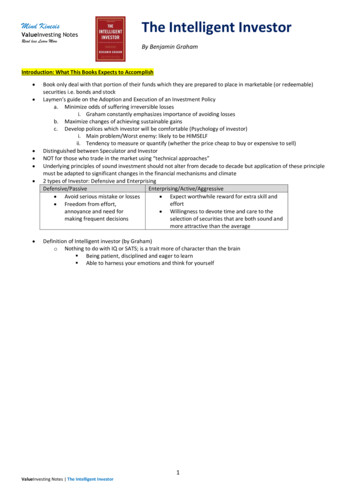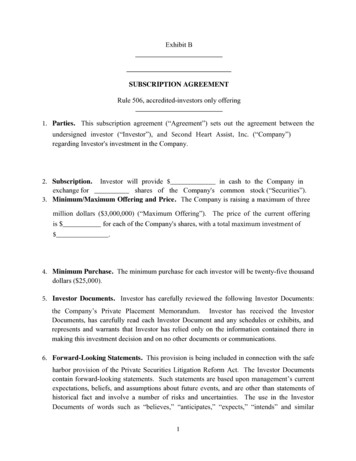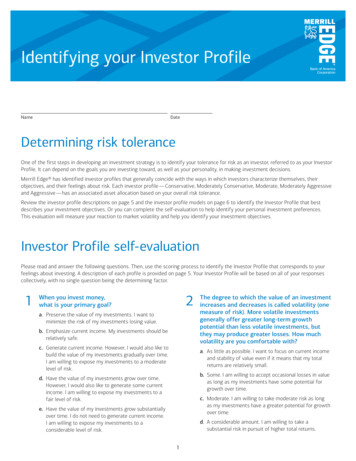
Transcription
Investor HandbookCOUNTRY Capital Management Company 1705 Towanda Avenue, P.O. BOX 2222 Bloomington, IL 61702-2222
What’s inside?Type and scope of services1Product offerings1Fees and expenses2Mutual funds and 529 Plans3Variable insurance contracts5Compensation and other conflicts of interest7This handbook provides important information to help youunderstand the type and scope of securities products and servicesavailable through COUNTRY Capital Management Company(CCMC), material fees and costs that may apply, and conflicts ofinterest associated with a recommendation. CCMC is part of theCOUNTRY Financial family of affiliated insurance and financialservices companies.Please read this information carefully and retain it for yourrecords. If you have any questions regarding this informationor to request a current copy of the Investor Handbook or theCustomer Relationship Summary (Form CRS), please contact yourCCMC financial professional or our home office in Bloomington,Ill. at 866-551-0060. You can also find a current copy of FormCRS and the Investor Handbook at ormation contained in this handbook is current as ofJune 30, 2020, and supersedes prior Investor Handbooks youmay have received.
Type and scope of servicesCCMC is registered with the Securities and Exchange Commission (SEC) as a broker-dealer and is a member of the Financial Industry RegulatoryAuthority (FINRA). We facilitate purchases and provide certain ongoing services under selling agreements with select third-party companies(“product sponsors”) that issue the following products: Mutual funds 529 savings plans Variable insurance contractsWhile our product offerings are carefully chosen to meet a wide variety of investment needs, other firms may offer a broader range of securitiesto choose from, and they may offer the same or similar investments with different features, benefits and costs. We choose product sponsors afteranalyzing factors such as the competitiveness of their products, technology, customer service and training capabilities. Our ability to offer theseproducts is limited to the states that we are registered to do business in.What to expect when you are doing business with usOur services are made available through individuals that are trained, supervised and authorized to work with you on our behalf (herein referredto as “financial professionals”). Your financial professional may ask you a lot of questions; it is important for you to provide complete and accurateinformation in order for us to offer you the most suitable options for your situation. Answer as honestly and openly as you can, and if you don’tknow the answer, your financial professional will work with you to figure it out. We are obligated to ensure that recommendations are suitablebased on factors including your investment goals and objectives, financial and tax status, and other financial information you have provided to us.While it is important for you to understand that we don’t have a fiduciary obligation to you under applicable law, we are obligated to act in yourbest interest. This means that when we make a recommendation involving a securities transaction or investment strategy, we are not allowed toplace our interests ahead of yours. To meet this obligation we will strive to: 1) provide full and fair disclosure of material facts and informationrelated to the recommendation; 2) exercise reasonable diligence, care and skill to make sure that recommendations are appropriate for yoursituation; and 3) establish, maintain and enforce policies and procedures to address conflicts of interest.While we will take reasonable care in developing and making recommendations to you, securities investing involves risk, and can result inlosing money. There is no guarantee that you will meet your investment goals, or that our recommended investment products or strategies willperform as anticipated. It is also important for you to understand that we are not obligated to monitor your investments or update previouslyprovided recommendations. Accordingly, our silence should not be viewed as a recommendation to hold an investment. You are responsible forindependently ensuring that your investments remain appropriate given your investment objectives, risk tolerance, financial circumstances andinvestment needs. We strongly encourage you to talk to your financial professional periodically and whenever your circumstances change, as somechanges may affect the products or strategy you and your financial professional have put in place. Your financial professional will not provide youwith tax or legal advisory services, and no one associated with us is authorized to render such advice as a service provided through us. You areencouraged to consult a tax and/or legal advisor to determine the appropriate tax/legal treatment of your transactions.The product sponsor or its custodian actually holds the assets and is responsible for providing services such as generating account/contractstatements, clearing/settling transactions, issuing tax documents and providing ongoing prospectus delivery. The ability to transfer a specificsecurity from one broker-dealer to us may depend on the product sponsor having entered into an agreement (often called a “selling agreement” or“distribution agreement”) with us. It is within the discretion of the product sponsor and us to enter into a selling or distribution agreement.Product offeringsWe recommend products based on your financial goals and needs; however, our recommendations are limited by the securities products weoffer. Refer to the chart below and ask your financial professional questions about reasonably available alternatives and where to find additionalinformation about these products:Product typeDescriptionOffering documentSection 529Savings PlanS(“529 Plans”)529 Plans are tax-advantaged accounts designed to encourage saving for futureeducation costs. They are sponsored by states and authorized under Section 529 ofthe Internal Revenue Code. With a 529 Plan you contribute to an investment accountset up specifically to pay a beneficiary’s qualified education expenses, such as tuition,mandatory fees, books, supplies, and room and board. 529 Plans offer a range ofinvestment choices, which are typically various mutual fund portfolios.A 529 Plan’s program disclosurestatement provides importantinformation including, butnot limited to, the investmentobjectives, fees, expenses andrisks that you should carefullyconsider before investing in theplan.Mutual FundsA mutual fund pools money from many investors and invests the money in stocks, bonds,short-term money-market instruments or other securities. Investors receive shares of themutual fund, which are valued based on the value of the underlying investments. Mutualfunds have a portfolio manager or a team that selects the investments for the fund inpart based on the fund’s objectives and risk tolerance. There are many types of mutualfunds, including, but not limited to, index funds, stock funds, bond funds, internationalA mutual fund’s prospectus(or summary prospectus)provides important informationincluding, but not limited to,the investment objectives, fees,expenses and risks that you1
VariableAnnuitiesfunds and money market funds. Each mutual fund type may have a different investmentobjective, strategy and/or investment portfolio. Different mutual funds may also besubject to different levels of risk, volatility, and fees and expenses depending on theinvestments held inside the mutual fund.should carefully consider beforeinvesting in the fund.A variable annuity is a contract between you (the contract owner) and an insurancecompany. You purchase an annuity contract by making either a single payment ora series of payments. Once an annuity contract has been purchased, the insurancecompany agrees to make periodic payments to you, beginning either immediately orat some future date. Not all of the annuity contracts and benefits described below areavailable in all states.A variable annuity’s prospectusand its sub-accounts’prospectuses provide importantinformation including, butnot limited to, the investmentobjectives, fees, expenses andrisks that you should carefullyconsider before investing in theinsurance contract.The premiums you pay are allocated among a number of sub-accounts or investmentportfolios (e.g., equities, fixed income, money market, etc.) that are offered as part ofthe contract. Sub-accounts are similar to, but not the same as, mutual funds. While asub-account may have a name similar to a mutual fund, it is not the same pool of fundsand may experience different performance than the mutual fund of the same or similarname. The return on a variable annuity investment will depend on your investmentallocation and the performance of the subaccounts you choose minus your contractexpenses. You may experience a negative return in a variable annuity sub-account.VariableUniversal LifeInsurance(Not currentlyaccepting newapplications)A flexible premium variable universal life insurance contract provides a death benefit andhas the potential to build up cash value. With flexible premiums, within limits, you areallowed to increase or decrease your coverage or change your premium after the contractis issued. You can choose among variable sub-accounts and a fixed sub-account in whichto invest your net premium payments and any cash contract value. Cash value fluctuatesaccording to the investment performance of the portfolio of these variable sub-accounts.A variable universal lifeinsurance’s prospectusprovides important informationincluding, but not limited to,the investment objectives, fees,expenses and risks that youshould carefully consider beforeinvesting in the insurance policy.Key points to know about these product offeringsThe products we offer are not guaranteed or insured by the FDIC or any other government agency. You can lose money investing in the products weoffer. It’s also important to understand the following: Before deciding to execute our recommendation, read the prospectus, sales literature and other documents associated with the security beingdiscussed; pay particular attention to the costs, fees and risk factors of the investment. It is normal to find these documents overwhelming andthe terminology foreign. Let your financial professional or our home office know if you don’t understand something, and we will provide you theinformation you need to feel comfortable and confident in the decisions you are making. Past performance is not a reliable indicator of future performance. However, past performance can help you assess a product’s volatility over time.Fees and expensesWhen pursuing your financial goals, it’s important that you not only consider the benefits and risks of an investment, but also the cost. Aswith anything you buy, there are fees and expenses associated with the products that we offer. Some investments, such as mutual funds, incurannual ongoing costs, which can include management, marketing or servicing expenses. These expenses are deducted from the fund’s assets,which impacts returns over time. It’s important for you to understand that even a small amount of ongoing fees and expenses can significantlyreduce your investment’s return over time. For example, as shown in the chart below, if an investor makes a 10,000 purchase of a hypotheticalinvestment and holds it for 30 years, assuming an annual return of 5%, the ending value will be over 22,000 more if the annual fee is 0.25%compared to 3.0%.Example of annual fee impactAnnual FeeValue after 30 yearsFees charged0.25% 40,237 2,9800.5% 37,453 5,7661.0% 32,434 10,7832.0% 24,273 18,9463.0% 18,114 25,105Many products charge a transaction-based fee every time you make a purchase, which is often called a “sales charge” or “sales load.” Sales loads can be front-endin that they are assessed at the time you make your investment or back-end in that you are assessed the charge if you sell the investment, usually within a specifiedtime frame. To demonstrate the effect of fees and expenses, the table below shows the values of a hypothetical investment of 10,000 with a 5% annual rate ofgrowth using different up-front sales charges and annual expenses similar to the costs described above.2
Example of sales charge and annual expense impactCosts (in percentages of investment)Up-front chargesAnnual expenses0%0.25%Holding period (in years)151530 10,475 12,612 20,059 40,2370%0.65% 10,435 12,373 18,940 35,8730%4.0% 10,100 10,510 11,610 13,4783.5%0.65% 10,070 11,940 18,277 34,6185.75%0.65% 9,835 11,661 17,851 33,811Mutual funds and 529 PlansBefore investing in mutual funds or 529 education savings plans, it is important that you understand the sales charges, fees and expenses thatwill apply, as well as any sales charge discounts or waivers (generally known as “breakpoints”) that may be available. The costs associated with aninvestment can vary significantly, even within a specific product type, and a small difference in costs can make a big difference in your returns overtime. Therefore, you should discuss these issues with your financial professional and review each product’s offering documents to get informationspecific to any investment you are considering before making a decision.Most mutual funds and 529 plans offer different pricing options, which are generally referred to as “share classes.” Although each share classrepresents a similar interest in the product (and/or its investment options), your investment will be subject to different sales charges, fees andexpenses depending upon your choice of share class. We do not offer all share classes that are made available, but generally offer share classes“A” and “B.” Many states also offer direct-sold 529 Plans, which can significantly lower your costs if you do not need the assistance of a financialprofessional.Class “A” sharesAs a general rule, Class A shares carry a “front-end” sales charge or “load” that is deducted from your investment at the time of purchase. Thissales charge may be up to a maximum of 5.75% of your total purchase amount. As explained below, many mutual funds and 529 Plans offer volumediscounts to the front-end sales charge assessed on Class A shares at certain pre-determined levels of investment. Class A shares may also imposeongoing asset-based sales charges, but they are generally lower than the ongoing charges associated with Class C shares (often 0.25 of assetsannually). Due to this cost structure, Class A shares are usually most appropriate for long-term investing or when breakpoint discounts will apply.Class “C” sharesIn contrast, Class C shares do not carry any front-end sales charges, so the full dollar amount you pay is invested. Instead, investors that purchase ClassC shares pay ongoing asset-based sales charges that are typically higher than the ongoing charges associated with Class A shares (up to 1% of assetsannually). Class C shares often also impose an additional charge, known as a contingent deferred sales charge, when a sale is made within a short timeof purchase (typically within 12 to 18 months). Class C shares are generally most appropriate for small investment amounts and may be consideredappropriate for short holding periods and/or if you are seeking the flexibility of transferring assets across mutual fund families.Other costsMutual funds purchased in certain account types, such as an IRA, may be subject to ongoing account maintenance and administration fees chargedby the account custodian or trustee. The state sponsor and plan manager for a 529 Plan may also charge fees. There may be an enrollment/applicationfee, as well as ongoing program management and account administration fees, which could be as high as 0.7% of assets annually. In addition to thesales charges and fees that you pay directly, mutual funds (and other 529 Plan underlying investment options) can pay certain regular and recurringoperating expenses out of the assets they hold. For example, these expenses may include the costs of administration, compliance distribution, assetmanagement, marketing, shareholder servicing, and record keeping. While you are not paying the expenses directly, they can still substantially impactinvestment performance over time. These operating expenses are usually expressed in the form of a percentage of average net assets, which isreferred to as an “expense ratio.” Ranges of expense ratios vary depending largely upon whether the assets held in the product are actively managedor passively managed to follow a market index. If passively managed, the typical ratio is around 0.4% or lower. If actively managed, the typical ratioranges between approximately 0.5% to 1.25%.Summary of typical share class differencesShare classACFront-end sales charge (maximum 5.75%)YesNoContingent deferred sales chargeNoYes (typically charged 12-18 months after purchase)Ongoing asset-based charges (typical ranges)0.25% or lessUp to 1.0%Sales charge discounts availableYesNoBreakpoint discountsMost mutual funds and 529 Plans offer a way to qualify for discounts on sales charges associated with the purchase of Class A shares. In general,these products provide breakpoint discounts to investors who make large purchases at one time. The extent of the discount depends upon the size3
of the purchase. Generally, as the amount of the purchase increases, the percentage used to determine the sales load decreases. In fact, theentire sales charge may be waived for investors that make very large purchases of Class A shares. Mutual fund prospectuses contain tables thatillustrate the available breakpoint discounts and the investment levels at which breakpoint discounts apply. Additionally, most of these productsallow investors to qualify for breakpoint discounts based upon current holdings from prior purchases through “Rights of Accumulation,” and futurepurchases, based upon “Letters of Intent.” This document provides general information regarding Rights of Accumulation and Letters of Intent.However, mutual funds and 529 Plans have different rules regarding the availability of Rights of Accumulation and Letters of Intent. Therefore, youshould discuss these issues with your financial professional and review the offering documents to determine the specific terms upon which theproduct offers Rights of Accumulation or Letters of Intent.Rights of AccumulationIn addition, many mutual funds allow investors to count the value of holdings in accounts of certain related parties, such as spouses or children,to qualify for breakpoint discounts. Each mutual fund has different rules that govern when relatives may rely upon each other’s holdings toqualify for breakpoint discounts. You should consult with your financial professional or review the mutual fund’s prospectus or statement ofadditional information to determine what these rules are for the fund family in which you are investing. If you wish to rely upon the holdings ofrelated parties to qualify for a breakpoint discount, you should advise your financial professional about these accounts. You may need to providedocumentation to your financial professional if you wish to rely upon balances in accounts at another firm.These products also follow different rules to determine the value of existing holdings. Some funds use the current net asset value (NAV) of existinginvestments in determining whether an investor qualifies for a breakpoint discount. However, a small number of funds use the historical cost,which is the cost of the initial purchase, to determine eligibility for breakpoint discounts. If the mutual fund uses historical costs, you may needto provide account records, such as confirmation statements or monthly statements, to qualify for a breakpoint discount based upon previouspurchases. You should consult with your financial professional and review the mutual fund’s prospectus to determine whether the mutual fund usesNAV or historical costs to determine breakpoint eligibility.Letters of IntentMost mutual funds and 529 Plans allow investors to qualify for breakpoint discounts by signing a Letter of Intent, which commits the investor topurchasing a specified amount of Class A shares within a defined period of time, usually 13 months. For example, if an investor plans to purchase 50,000 worth of Class A shares over a period of 13 months, but each individual purchase would not qualify for a breakpoint discount, the investorcould sign a Letter of Intent at the time of the first purchase and receive the breakpoint discount associated with the 50,000 investment on thefirst and all subsequent purchases. Additionally, some funds offer retroactive Letters of Intent that allow investors to rely upon purchases in therecent past to qualify for a breakpoint discount. However, if an investor fails to invest the amount required by the Letter of Intent, the fund isentitled to retroactively deduct the correct sales charges based upon the amount that the investor actually invested. If you intend to make severalpurchases within a 13-month period, you should consult your financial professional and the mutual fund prospectus to determine if it would bebeneficial for you to sign a Letter of Intent.Other sales charge waiversMost fund families also offer a right to exchange holdings of a fund within that fund family for another fund within the fund family, without anadditional sales charge. Various conditions and restrictions may apply, depending on the fund family, and are outlined within the prospectus. Someof those conditions and restrictions relate to: Time frame (e.g., shares must be held for a specific time period prior to the exchange)Exchanges may be limited to the same share classExchanges may be limited to a maximum number per yearFees may be charged for certain exchangesIn addition, some families of funds offer a reinstatement feature. This permits an investor who previously owned shares in a mutual fund torepurchase shares in the same fund (or in another fund within the same fund family) without paying an additional sales charge. Some restrictionsmay apply; for instance, there may be a time limit (e.g., six months or a year from the date of the initial sale) within which the reinstatementfeature must be exercised or it is lost. Funds may also limit the use of their reinstatement feature by an investor to one time for any given groupof shares. Contingent deferred sales charges, paid by an investor at the time of sale, may be reimbursed upon reinstatement, depending upon theterms stated in the prospectus. Additionally, some fund families permit reinstatement at NAV if the monies being reinstated are coming from thesale of shares from a different fund family where the investor previously paid a sales charge.As you can see, understanding the availability of breakpoint discounts is important because it may allow you to purchase Class A shares at a lowerprice. The availability of breakpoint discounts may save you money and may also affect your decision regarding the appropriate share class in whichto invest. Therefore, you should discuss the availability of breakpoint discounts with your financial professional and carefully review the mutualfund prospectus and its statement of additional information, which you can get from your financial professional, when choosing among the shareclasses offered by a mutual fund.Specific considerations for 529 PlansParticipation in a 529 Plan does not guarantee that contributions and investment return, if any, will be adequate to cover future tuition and othereducation expenses. Contributors to the program assume all investment risk, including potential loss of principal and liability for penalties such asthose levied for non-educational withdrawals. Depending upon the laws of the home state of the contributor or designated beneficiary, favorablestate tax treatment or other benefits offered by such home state for investing in 529 Plans may be available only if the contributor invests in thehome state 529 Plan. Any state-based benefit offered with respect to a particular 529 Plan should be one of many appropriately weighted factors tobe considered in making an investment decision.4
Assets in a 529 Plan can potentially reduce the beneficiary’s ability to qualify for some forms of financial aid. You should consult with your financial,tax or other adviser to learn more about how state-based benefits (including any limitations) would apply to your specific circumstances, and youalso may wish to contact your home state or any other 529 Plan to learn more about the features, benefits and limitations of your state’s 529 Plan.We will ask you for information about the designated beneficiary of the 529 Plan, including (among other things) information regarding the ageof the beneficiary and the number of years until funds will be needed to pay qualified education expenses of the beneficiary. These are importantfactors for us to consider, as the number of years until the first anticipated withdrawal for educational purposes is expected to be made can be asignificant factor in determining which share class would be suitable for this investment. In general, Class A shares will result in the lowest totalcost for beneficiaries under 12 years old if the account’s intended purpose is to help fund college education expenses and will not be used forprimary or secondary education expenses.The Financial Industry Regulatory Authority (FINRA) has developed an expense calculator to help investors calculate and compare the fees andexpenses for 529 plans (www.finra.org/529analyzer) and we encourage you to consult it. Complete information, including a description of fees,expenses and risks, is found in the product sponsor’s official offering statement or program description. These official disclosure statementsgenerally are available, at no charge, from the Electronic Municipal Market Access system (EMMA) at www.emma.msrb.org and can also beobtained through your financial professional.Variable insurance contractsWe are not registered to offer securities to residents of every state; furthermore, of the states we’re registered to do business in, we do not offervariable insurance contracts in all of them.A variable annuity may offer different “share classes” with different fees and expenses (including differing Mortality and Expense [M&E] charges)and different surrender charge periods. CCMC only offers “B class” variable annuities, which typically have a longer surrender charge period andlower ongoing fees.Variable insurance contracts are considered illiquid and are generally designed to be a long-term investment. You should ensure that you havesufficient funds from other sources to meet your liquidity needs in excess of the unrestricted withdrawals offered by the contract. Withdrawals, inexcess of any free withdrawals, may subject you to charges. Additionally, earnings withdrawn prior to age 59½ may be subject to a 10% tax penalty.Variable insurance contracts have several types of fees and charges within their contacts. It’s important that you understand all the expenses beforeyou invest, as the costs of variable insurance contracts are typically higher than those of mutual funds, and therefore will have an impact on thelong-term performance of your investment. These fees and charges can include:CostDescriptionMortality and expense(M&E) risk chargeThis charge is equal to a certain percentage of your account value, typically from 1.00% to 1.60% per year for retailcontracts. The M&E risk charge can be used by the insurance company to offset the costs of selling the variableannuity, such as a commission paid to your financial professional for selling the variable annuity to you, and tocompensate the insurance company for the insurance risks that it assumes under the insurance contract.Administrative feesThe insurer may deduct charges to cover record keeping and other administrative expenses. This may be charged asa flat account maintenance fee (perhaps 25 or 30 per year) and/or as a percentage of your account value (typicallyabout 0.15% per year). Some insurance companies waive the flat account maintenance fee on larger account values.Sub-account expenseYou will also pay fees and expenses imposed by the underlying investment options in a variable annuity. The feesand expenses of the sub-accounts include annual operating expenses such as management fees, 12b-1 (distribution)fees, cost of shareholder mailings, and other expenses. These expenses can range from 0% annually for moneymarket subaccounts to as much as 2% or more annually for certain equity subaccounts. For a detailed explanation ofthese expenses, see the prospectus(es) for the underlying funds.Fees and charges forother featuresIf you withdraw money from a variable insurance contact or surrender the contract within a certain period of timeafter investing, the insurance company may assess a form of contingent deferred sales charge that is commonlyknown as a “surrender charge.” Usually the surrender charge is a specified percentage that is deducted from theamount withdrawn and it declines gradually over a period of years, known as the “surrender period.” For example,a 7% surrender charge might apply in the first year after investing, 6% in the second year, 5% in the third year, andso on until the surrender charge reaches zero. Additional purchase payments made in the future may be subject toadditional surrender periods. Often, after the first year a contract will allow a limited portion of the contract’s valueto be withdrawn without paying a surrender charge.Surrender chargesCertain features offered by some variable insurance contracts—such as a stepped-up death benefit, a bonuscredit feature, a guaranteed minimum income benefit, a guaranteed minimum withdrawal benefit, a guaranteedminimum accumulation benefit, or an earnings enhancement benefit—often
This handbook provides important information to help you . risk tolerance, financial circumstances and investment needs. We strongly encourage you to talk to your financial professional periodically and whenever your circumstances change, as some . funds have a portfolio manager or a t










